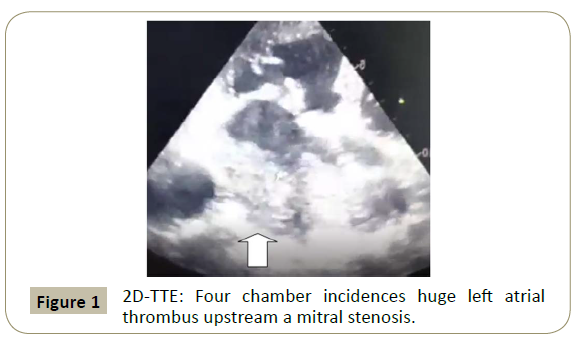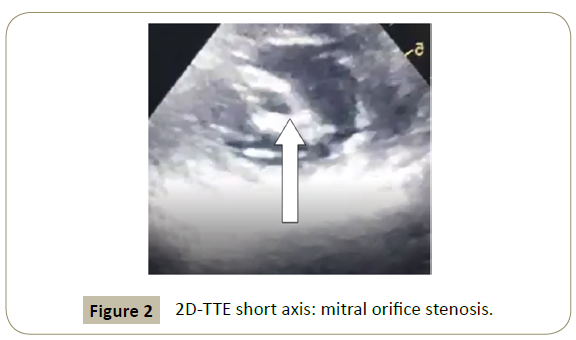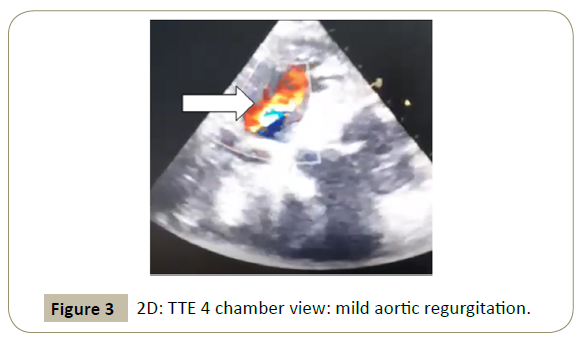Yaakoubi Wael*, Ben Rejeb Rym, Ben Hlima Manel, Rekik Bassem, Ouali Sana and Mourali Med Sami
De Hopital La Rabta Adult Cardiology Service Tunis Ministry of Public Health, Tunisia
- Corresponding Author:
- Wael Y
De Hopital La Rabta Adult Cardiology Service Tunis Ministry of Public Health
Tunisia
E-mail: yaakoubiwael3@gmail.com
Received Date: November 03, 2021; Accepted Date: November 17, 2021; Published Date: November 24, 2021
Citation: Wael Y, Rym BR, Manel BH, Bassem R, Sana O, et al (2021) A Giant Left Atrium Massively Thrombosed. Interv Cardiol J Vol.7 No.11:159 doi: 10.36648/2471-8157.7.11.159
Copyright: © 2021 Wael Y, et al. This is an open-access article distributed under the terms of the Creative Commons Attribution License, which permits unrestricted use, distribution, and reproduction in any medium, provided the original author and source are credited.
Keywords
Mitral valve; Stenosis; Thrombosis
Introduction
Echocardiography is the procedure of choice for the diagnosis of
cardiac mass involving the left atrium. It has been shown to be a
superior method in defining the characteristics of a mass in the
left atrium: as it helps to characterize the mass by morphologic
shape and appearance, site of attachment, types of margins, and
presence or absence in the left atrial appendage.
Case Report
This is a 70-year-old woman without cardiovascular risk factors,
having led four pregnancies without incidents, who has presented
one month ago a regressive cerebral vascular accident. She was put
by her neurologist under aspirin then addressed to the cardiology
department for etiological assessment of her stroke. The patient
complained no dyspnea or palpitation. Physical examination did
not reveal signs of heart failure. At heart auscultation she had
an apical diastolic rumble. Electrocardiography showed only an
atrial fibrillation. A hugely enlarged left atrium (antero-posterior
LA-diameter = 75 mm. left atrial volume =80 cm2 / 140 ml/m2)
occupied by a big thrombus (70 × 60 mm) was demonstrated by
transthoracic echocardiography (Figure 1).
Figure 1: 2D-TTE: Four chamber incidences huge left atrial thrombus upstream a mitral stenosis.
Evidence of calcified rheumatic mitral stenosis (mitral valve area
was about 0.7 cm2: measured with planimetry technique) (Figure
2) with mild regurgitation was seen.
Figure 2: 2D-TTE short axis: mitral orifice stenosis.
The two mitral commissures were fused and the sub-mitral valve
was retracted.
Tricuspid valve was severely incompetent with an estimated
pulmonary artery systolic pressure of 80 mmHg. The tricuspid
ring was dilated to 24 mm / m2. The aortic valve was also affected
by rheumatism, it was remodelled and the site of minimal
aortic insufficiency (Figure 3). After performing coronarography
which was normal the patient was addressed in emergency to
heart surgery department for mitral valvular replacement with
tricuspid annuloplasty associated with surgical thrombectomy.
Figure 3: 2D: TTE 4 chamber view: mild aortic regurgitation.
Discussion
Transthoracic echocardiography is the easiest and cheapest
method for the diagnosis and follow-up of the disease.
Transoesophageal echocardiography performed during the
operation helps the surgical team in evaluating the effectiveness
of artificial valves [1]. The terminology of huge left atrium is for
diameters larger than 6 cm and a left atrium with a diameter of
more than 12 cm is very rarely reported in the literature [2,3].
The causes of left atrium enlargement include mitral stenosis
or regurgitation, rheumatic valve, left ventricular failure,
hypertension, left ventricular diastolic dysfunction and atrial
fibrillation [4]. Long standing mitral valve disease is associated
with enlargement of the left atrium as a compensatory mechanism
due to increase intracavitary pressure and volume. Such an
enlargement is beneficial as it reduces pulmonary congestion,
thus it protects the lung from pulmonary hypertension and
oedema [5]. The aetiology of huge left atrium (LA) is still unknown.
The mechanism of formation of giant left atrium (GLA) is not
fully understood. Patients with chronic mitral valve disease are
not always associated with GLA. Only 19 % may develop such a
condition [6]. Previous studies showed that chronic pressure in the
left atrium is not the only cause of GLA, but weakening of the left
atrial wall by rheumatic pancarditis causing chronic inflammation
and fibrosis is also implicated [7]. Enlargement of the left atrium is
associated with development of atrial fibrillation, which in return
can lead to further enlargement of left atrium. Huge enlargement
of the left atrium is prone to develop various complications
including thrombus formation, thromboembolic events [8]. The
enlarged left atrium is associated with blood stasis and thrombus
formation. The risk of thromboembolism increases with left atrial
size regardless of anticoagulation [9]. LA dilation leads to thinning
and fibrosis of myocardial and conducting fibers and thereby results in electrical tissue inhomogeneity, disordered electrical activation
and contractility. Every 5 mm increase in LA diameter increases the
development of atrial fibrillation by 39% [10].
Previous studies found that the incidence of left atrial thrombus
among patients with mitral stenosis associated with AF varies
from 7-38%. Such an incidence is directly related to the size of
left atrium [10]. It is interesting to note that not all patients with
GLA have an associated thrombus formation [11]. Goldsmith and
colleagues, found that patients with mitral valve disease have
associated left atrial endocardial damage [12]. Such damage
contributed to the risk of thrombus formation. The other factor is related to the activation of coagulation system within the left
atrium [13]. Patients with mitral stenosis have a significantly
high level of fibrinopeptide A, thrombin-antithrombin III
complex and Von Willebrand factor antigen in the left atrium.
These biochemical markers are responsible for the formation
of thrombosis even during anticoagulation regardless of the
severity of mitral stenosis or size of left atrium. Our patient
had a mitral stenosis associated with chronic AF. Both factors
were responsible for the development of Giant Left Atrium and
thrombosis. In such situation medical treatment is based on
effective anticoagulation. The aim of surgery in giant left atrium
is to correct the mitral valve abnormalities, to treat compressive
manifestations, to prevent thromboembolism and to revert atrial
fibrillation into normal sinus rhythm especially by associating
plicature of left atrium at the mitral valve replacement. Plication
of the left atrium was not indicated in our patient, to avoid
unnecessary complication as circumflex coronary artery injury,
pulmonary vein obstruction and oesophageal stricture. Previous
study by Tonguc and colleagues [14], compared patients
undergoing mitral valve replacement (MVR) with or without
plication, found no significant difference in hemodynamic
improvement and reduction of left atrial diameter. Also, the
incidence of left atrial thrombus after MVR showed no difference
whether plication was performed or not [14]. If the thrombus is
big and organized thrombectomy is indicated however removal
of an organized thrombus from the left atrium can be challenging
especially when it is huge in size.
Conclusion
Cardiac thrombi appear more frequently than cardiac tumours.
They are typically located in the atrium, more often in the left, and
generally occur in patients with organic heart disease especially
mitral stenosis. Their treatment is often based on effective
anticoagulation with K antivitamins. Surgical thrombectomy is rarely
indicated, especially in the presence of large and organized ones.
References
- Sinatra R, Pulitani I, Antonazzo A (2001) A novel technique for giant left atrium reduction. Eur J Cardio-Thorac Surg Off J Eur Assoc Cardio-Thorac Surg 20: 412-4.
- Isomura T, Hisatomi K, Hirano A (1993) Left atrial plication and mitral valve replacement for giant left atrium accompanying mitral lesion. J Card Surg 8: 365-70.
- Kawazoe K, Beppu S, Takahara Y (1983) Surgical treatment of giant left atrium combined with mitral valvular disease. Plication procedure for reduction of compression to the left ventricle, bronchus, and pulmonary parenchyma. J Thorac Cardiovasc Surg 85: 885-92.
- Cuspidi C, Negri F, Sala C (2012) Association of left atrial enlargement with left ventricular hypertrophy and diastolic dysfunction: a tissue Doppler study in echocardiographic practice. Blood Press 21: 24-30.
- Schwammenthal E, Vered Z, Agranat O (2000) Impact of atrioventricular compliance on pulmonary artery pressure in mitral stenosis: an exercise echocardiographic study. Circulation 102: 2378-84.
- Di Eusanio G, Gregorini R, Mazzola A (1998) Giant left atrium and mitral valve replacement: risk factor analysis. Eur J Cardio-Thorac Surg Off J Eur Assoc Cardio-Thorac Surg 2: 151-9.
- Hurst JW (2001) Memories of patients with a giant left atrium. Circulation 104: 2630-1.
- Goldstein LB (2011) Left atrial enlargement: A cause of stroke? CMAJ Can Med Assoc J 183: 1129-30.
- Apostolakis E, Shuhaiber JH (2008) The surgical management of giant left atrium. Eur J Cardio-Thorac Surg Off J Eur Assoc Cardio-Thorac Surg 33: 182-90.
- Farman MT, Sial JA, Khan N (2010) Severe mitral stenosis with atrial fibrillation--a harbinger of thromboembolism. JPMA J Pak Med Assoc 60: 439-43.
- Darwazah AK, El Sayed H (2013) Giant left atrium associated with massive thrombus formation. Thromb J 11: 5.
- Goldsmith I, Kumar P, Carter P (2000) Atrial endocardial changes in mitral valve disease: a scanning electron microscopy study. Am Heart J 140: 777-84.
- Yamamoto K, Ikeda U, Seino Y (1995) Coagulation activity is increased in the left atrium of patients with mitral stenosis. J Am Coll Cardiol 25: 107-12.
- Tonguç E, Kestelli M, Özsöyler İ (2001) Limit of Indication for Plication of Giant Left Atrium. Asian Cardiovasc Thorac Ann 9: 24-6.




